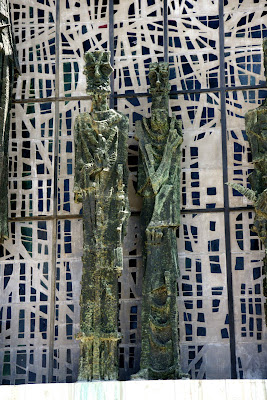Just beyond the outskirts of Leon we stopped at the Santuario of the Virgen of the Camino, the patron of León. The baroque statue of the Virgen inside the sanctuary belongs to the middle ages, but the building and its neo-gothic apostles on the facade are only fifty years old. We were fortunate to arrive while mass was being performed. Wandering about the interior we were startled to find a chapel dedicated to the Virgen of Guadalupe, the patron of Mexico. We chatted with the Arturo, the resident priest, who had studied in Encarnita's home city of Granada and learned that a very important benefactor for the sanctuary for many years had been a family from Mexico.

Facade, Virgen del Camino
 In San Martin we stopped for a snack in a delightful albergue, Albergue Santana. Whereas the standard albergue provides only dormitory style accommodation in rooms that hold 30 or 40 pilgrims, Benito, the owner, had concluded there were many pilgrims like us. His establishment provides a number of rooms with two beds, some with a double bed, and a private bathroom and shower. The entire facility was very modern and well equipped.
In San Martin we stopped for a snack in a delightful albergue, Albergue Santana. Whereas the standard albergue provides only dormitory style accommodation in rooms that hold 30 or 40 pilgrims, Benito, the owner, had concluded there were many pilgrims like us. His establishment provides a number of rooms with two beds, some with a double bed, and a private bathroom and shower. The entire facility was very modern and well equipped. The long romanesque bridge at Hospital de Orbigo has a story to tell. Well back in the middle ages, an important noble, Seur de Quiñones, was a prisoner of love. The lady who was the target of his affection continued to resist his suit. To break free, Quiñones and his eight knights challenged any and all to combat with lances. Challengers came from all over Spain and from other countries. For a week, on the field that lies at the foot of the bridge, knights engaged in jousting and several hundred combat engagements took place. When score was taken at the end of the week, and all this was recorded by a notary of the time, one knight from Navarre had been killed. The very definite edge Quiñones and his supporters had in the outcomes enabled Quiñones to feel freed from his prison of love. He then went to Santiago de Compostela and gave to the cathedral the bracelet he had wanted to present to his lady. To this day, the bracelet forms part of the high altar.
The long romanesque bridge at Hospital de Orbigo has a story to tell. Well back in the middle ages, an important noble, Seur de Quiñones, was a prisoner of love. The lady who was the target of his affection continued to resist his suit. To break free, Quiñones and his eight knights challenged any and all to combat with lances. Challengers came from all over Spain and from other countries. For a week, on the field that lies at the foot of the bridge, knights engaged in jousting and several hundred combat engagements took place. When score was taken at the end of the week, and all this was recorded by a notary of the time, one knight from Navarre had been killed. The very definite edge Quiñones and his supporters had in the outcomes enabled Quiñones to feel freed from his prison of love. He then went to Santiago de Compostela and gave to the cathedral the bracelet he had wanted to present to his lady. To this day, the bracelet forms part of the high altar.


1 comment:
Great pictures!!!
As mentioned in my e-mail, I have to postpone one week my dates with you due to business meetings next week.
I'll call you later
Buen Camino
Kike
Post a Comment